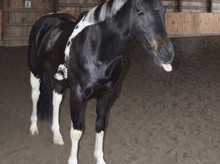Yesterday morning I noticed that Betsy Ross’ vent area (for you chicken neophytes, that’s her butt) was messy with runny poops. I bathed her bottom (gentle dog shampoo in warm water) and could then see that she was suffering from a prolapsed cloacae. This happens when a hen lays an egg that is too big, and she pushes out some of the vent along with the egg.
All of the extension service poultry Web sites will inform you that a prolapse is cause for culling. The other hens will peck at the red butt (the sites don’t use these exact words), and/or infection will set in. Besides, once a hen prolapses, even if fixed, it’ll happen again.
I’ll try to save Betsy. I purchased some Preparation H, and applied it several times yesterday. I pushed the prolapse back in. But it doesn’t stay in. She’s been moved into a little dog crate, safe from the other hens. She’s eating and drinking and bright-eyed. No infection yet. I’m not optimistic, but I won’t give up on her.
As with any animal that you own, you are responsible for their well-being. You do the best you can. But there are limits, especially with farm animals. A farmer could more easily put a price on what it is worth to save her, both in time and money. In my little farmette, Betsy straddles that line between pet and producer. I’ll nurse her. I’ll bathe her. I’ll take the time to care for one little hen. But, she won’t be going to the vet (which would be a costly long-shot) and I’m prepared to cull her if she suffers. This is the reality of living with chickens.

